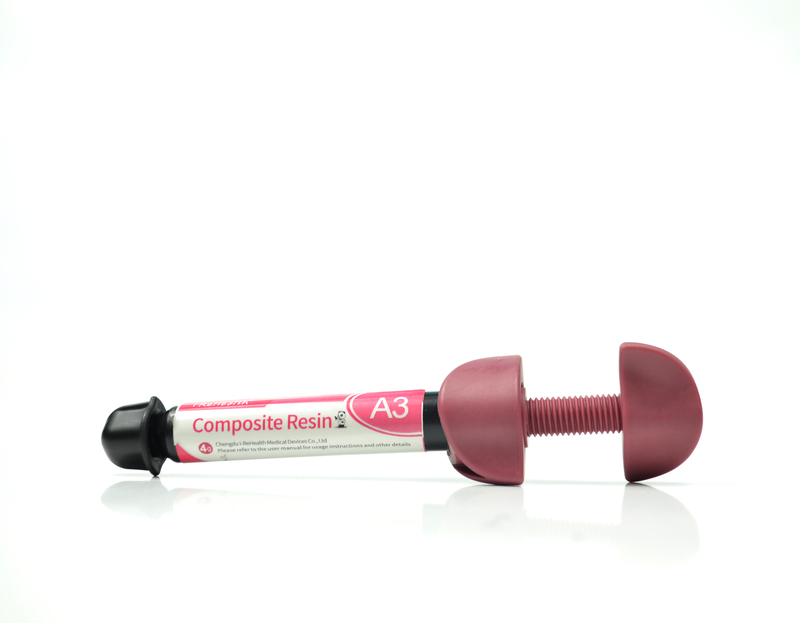Composite Resin
Composite Resin
Composite Resin
- 产品详情
【Product name】Composite Resin
【Specification】1.0g/ 2.0g/ 3.0g/ 4.0g/ syringe
【Model】A1D, A2D, A3D, A4D, B3D, C4D, WD, A1B, A2B, A3B, A3.5B, A4B, A6B, B1B, B2B, B3B, B5B, C1B, C2B, D2B, D3B, A1E, A2E, A3E, B1E, B2E
【Ingredients】 Composite Resins is a light-curing nano-composite for the adhesive filling technique. lt mainly composed of Bis-GMA, UDMA, PEGDMA, Filler content 77% by weight Inorganic filler.
【Application】
● Direct anterior and posterior tooth restorations in Black's classes Ⅰ, Ⅱ, Ⅲ, Ⅳ, and V
● Indirect restorations such as inlays, onlays and veneers
● Post-core restoration
【Applicable Scenarios】
● Preparation of the natural tooth
● Before starting the treatment, clean the hard tissue with fluoride-free polishing paste
● Choose the color using the Vita*-shade guide while the tooth is still moist.
【Certification】 ISO13485/ Free Sales Certificate
【Product properties】
● Fillings. Fill cavities caused by tooth decay, providing a natural-looking restoration.
● Cosmetic Enhancements. Reshape teeth, close gaps, and improve the overall appearance of a smile.
● Versatility. Both for restorative and cosmetic purposes, offering a wide range of applications.
● Minimal Removal of Healthy Tooth Structure. Usually require less removal of healthy tooth structure during placement.
【Storage conditions】 Store at room temperatures and avoid direct sunlight.
【Service life】Unopened for 3 years,.
【Contraindications】Contraindicated in patients with allergies to the components of this product.
【Special reminder】Only for use in dentistry, keep out of children's reach
.
【Caution】
1. The dentist should consider known interactions and cross reactions of the product with other materials already in the patient's mouth before using the product.
2. Unpolymerized resin may lead to skin allergies.
3. Phenolic substances (e.g. eugenol) inhibit polymerization, therefore these materials (e.g. zinc oxide eugenol cements) must not be used as liners.
4. Discoloration may occur upon using of chlorhexidine or oral washing liquids.
【Package】
| 1.0g/ syringe | 1 syringe x 1 bag |  |
| 2.0g/ syringe | 1 syringe x 1 bag | |
| 3.0g/ syringe | 1 syringe x 1 bag | |
| 4.0g/ syringe | 1 syringe x 1 bag |

Polymerization time: 20 seconds
【How to use】
1. Cavity Preparation
Gently prepare the hard tissue according to the rules of the adhesive technique. When working on anterior teeth, bevel all enamel edges. Do not bevel the edges when working on posterior teeth. Avoid featheredged margins. Next, clean the cavity with water spray, remove all residues and dry. Complete drying is necessary. We recommend the use of a rubber dam.
2. Pulp Protection/ Liner
When using an enamel-dentin adhesive, the liner can be foregone. In case of very deep cavities near the pulp, line with a calcium hydroxide compound accordingly.
3. Design of Approximal Sections
In cavities with approximal sections, set in a transparent matrix and fix.
4. Filling with Light-Cured Composite Resin
Apply the etching gel to the prepared surface, etch for 30 seconds on enamel or 15 seconds on dentin, then rinse off the etching gel thoroughly with water. Avoid drying the dentin. The dry, etched enamel surface will appear greyish white and must be kept free of contamination before the adhesive is applied. If the prepared area is contaminated with saliva, rinse and dry again. Etch again if necessary. Shake Bond LC well and apply the adhesive generously to the dentin and enamel surfaces with a brush, applying vigorously for approximately 30 seconds. Afterwards, blow dry carefully with oil-free compressed air for approximately 15 seconds. After curing the adhesive layer for 20 seconds using a polymerizing lamp (light-curing device), apply a second coat of adhesive in the same manner.
5. Application of the Composite
Take the required amount of composite out of the application tip. Fill the cavity with the material and shape as needed by using conventional metal instruments. A layer thickness of 2 mm must not be exceeded. Due to the oxygen in the ambient air, a thin dispersion layer will remain on top of each layer. This dispersion layer forms the chemical bond between the layers and must not be touched or contaminated with moisture.
6. Polymerization
The polymerization time is 20 sec, per layer for colors with a commercial polymerization system, an LED polymerization lamp or 2 x 3 sec, with a plasma polymerization system. Hold the light-guide as close to the surface of the filing as possible. Fillings with several surfaces should be polymerized from the direction of each surface.
7. Finishing
Nano Composite can be finished and polished immediately after polymerization. Available grinding tools include finishing diamonds, flexible split disc silicone polishers and polishing brushes. Check the occlusion and functional movement, adjust if necessary, and finally polish with a suitable polishing paste.
Special Instructions
The working range under a surgical light is 2 min. In case of extensive restorations, the surgical light should be moved away from the working area temporarily to avoid premature curing of the composite. Alternatively, the material can be covered with alight-tight foil.
Use a light polymerization system with an emission range of 450 nm and intensity of 500mW/cm2 to polymerize the material. The required physical properties are only reached if the polymerization light functions properly. Therefore, it is necessary to check the light intensity regularly.
